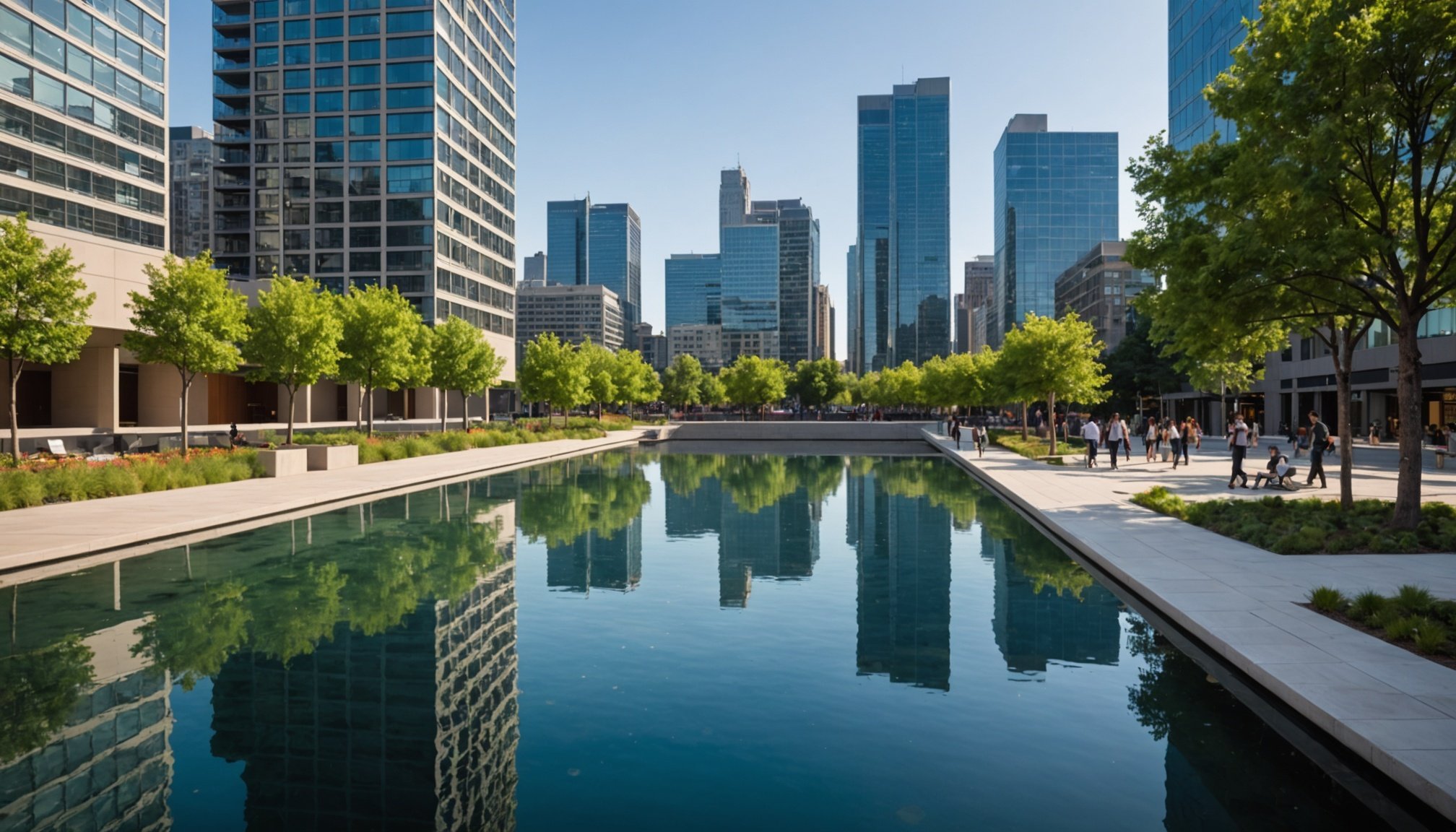Overview of Eco-Friendly Water Features
The integration of water features into urban spaces plays a crucial role in advancing sustainability efforts. As cities seek greener solutions, eco-friendly water features have gained momentum in sustainable design. They beautifully merge aesthetic appeal with environmental consciousness, making them an essential component of urban innovation.
Key characteristics of eco-friendly water features include the use of sustainable materials, operation through renewable energy sources, and the focus on water conservation. These features help in reducing the carbon footprint by incorporating solar panels or wind turbines, thus aligning with green infrastructure goals.
Also to see : Navigating Coastal Real Estate in the UK: Essential Strategies and Insights for Regulatory Mastery
The latest trends in design and technology advocate for smart water management systems that ensure the efficient recycling and conservation of water. Additionally, the selection of materials such as recycled glass or permeable concrete further supports eco-friendliness. By prioritizing these technologies and materials, urban planners can create spaces that cater to both ecological balance and human well-being.
In this era of urban innovation, water features no longer serve purely decorative purposes. Instead, they have become formidable agents of sustainable design, contributing to the creation of thriving, resilient cities.
Additional reading : Navigating Coastal Real Estate in the UK: Essential Strategies and Insights for Regulatory Mastery
Innovative Designs in Water Features
Innovative designs in water features are transforming urban landscapes, emphasizing sustainable architecture and modern landscaping. These designs not only offer visual appeal but also incorporate elements of sustainability, creating a harmonious balance between nature and urbanity.
Cutting-edge examples include floating gardens, which integrate water bodies with green spaces to foster biodiversity. These gardens serve dual purposes—providing habitats for aquatic life and offering recreational spaces for residents. Another example is the interactive fountains that utilize motion sensors to control water flow, thereby conserving water while creating engaging public art.
Case studies illustrate successful urban implementations, such as the Green Roof Water Recycling System in Singapore. This project cleverly combines green roofs and water recycling technologies, reducing runoff and promoting efficient water reuse. These examples highlight how innovative designs can be both aesthetically pleasing and environmentally friendly.
Aesthetics play a crucial role in promoting environmental consciousness. Beautifully designed water features can inspire public interest and awareness in sustainability. When integrated thoughtfully, such features not only enhance urban beauty but also educate and motivate city dwellers to embrace eco-friendly lifestyles, reinforcing the importance of sustainable living.
Technologies Driving Sustainable Water Features
By integrating sustainable technology, urban planners can significantly enhance the environmental impact of water features. These technologies are instrumental in promoting water conservation and supporting green infrastructure.
Smart Water Management Systems
Smart systems provide the backbone for efficient water usage. They optimise water recycling processes, ensuring minimal waste. Such systems can automatically adjust based on climate conditions to conserve this vital resource.
Renewable Energy Utilization
Water features powered by renewable energy, such as solar panels and wind turbines, are advancing green goals. This energy shift reduces reliance on non-renewable sources while maintaining functionality, aligning with eco-friendly practices.
Eco-Friendly Materials
Selecting eco-friendly materials is paramount in sustainable construction. Sustainable options like recycled glass and permeable concrete minimize environmental footprints, further reinforcing the ecological balance of urban landscapes. These materials prevent harmful waste and contribute to durable, resilient structures.
Together, sustainable technology and eco-conscious resources are vital in designing contemporary water features. By focusing on water preservation and renewable energy, urban landscapes can achieve greater harmony with nature. Understanding and implementing these technologies is crucial for sustainable urban development, enabling cities to thrive in an eco-friendly manner.
Benefits of Eco-Friendly Water Features
Modern water features significantly enhance urban biodiversity, providing essential habitats for various species. By incorporating these features into cityscapes, urban planners support not only plant life but also aquatic creatures and birds, creating ecological balance. This biodiversity contributes to a resilient urban environment, helping cities withstand climate challenges more effectively.
Beyond ecological advantages, eco-friendly water features offer considerable psychological benefits. They introduce natural elements into often sterile urban environments, promoting relaxation and reducing stress for residents. Studies suggest the presence of water can improve mental health, offering a calming effect and enhancing overall well-being. These features provide a tranquil escape amidst urban chaos, encouraging mindfulness and rejuvenation.
Moreover, the aesthetic contribution of these water features bolsters environmental awareness. By seeing nature integrated into their surroundings, city dwellers develop a deeper appreciation for the environment. The beauty of these installations can inspire a collective shift towards sustainable lifestyles, fostering environmental consciousness.
In terms of local ecosystems, water features serve as vital sources, supporting ecological functions by cycling nutrients and aiding in water purification. Thus, they play an integral role in maintaining and enhancing city ecosystems, ultimately contributing to urban innovation.
Practical Implementation Strategies
Successful city planning requires detailed strategies for integrating eco-friendly water features into urban environments. Planners must collaborate with landscape architects to ensure these features align with broader sustainable practices. Such collaboration encourages creativity while ensuring design effectiveness, seamlessly blending form with function.
When contemplating water features, planners should establish clear guidelines to manage their positioning, scale, and environmental impact within urban spaces. Choices must consider existing infrastructure and local ecology to enhance compatibility and ecological benefits. This approach optimizes urban biodiversity and supports natural habitats.
Effective landscape architecture balances aesthetic appeal with practical solutions, enhancing sustainability without compromising on visual allure. Features like cascading waterfalls or reflective ponds can enhance public spaces while serving their environmental roles.
Maintenance practices are vital to the longevity and sustainability of water features. Long-term care involves employing eco-conscious cleaning methods and ongoing inspections to prevent water waste and ensure mechanical efficiency. By investing in robust maintenance routines, urban spaces can consistently benefit from these eco-friendly installations.
In essence, merging these strategic guidelines and partnerships creates a comprehensive, sustainable approach to water features, enhancing urban environments both aesthetically and ecologically.
Expert Insights and Future Trends
Expert opinions play a pivotal role in shaping the future of eco-friendly water features. Landscape architects and ecologists advocate for integrating water features as core components of urban sustainability. These experts highlight the importance of adapting to climate change by developing resilient infrastructure, emphasizing the potential of water features to mitigate urban heat islands.
Looking forward, future developments in water feature technology are anticipated. Experts foresee advanced data-driven systems that monitor water quality and optimize resource usage. This technological evolution aims to enhance the efficiency and sustainability of urban water features.
Moreover, the integration of AI and machine learning in water management systems promises more precise control over water conservation efforts. These technologies enable real-time adjustments in response to environmental changes, ensuring water features remain sustainable and effective.
As cities evolve, so does the necessity for urban sustainability in planning. Planners and designers have the challenge to balance technological advancements with ecological principles. By aligning with expert insights, future urban planning can foster environments that support biodiversity, human well-being, and resilience. This forward-thinking approach positions water features as integral to the sustainable growth of modern cities.


